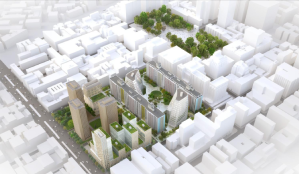 Nearly a year ago, N.Y.U. unveiled its expansion plan for the next 25 years, which would add 6 million square to the university–already the third-largest landowner in the city, behind the Catholic Church and Columbia. The plan was met with immediate outcry from the Greenwich Village community–which had worked for years to help outline the plan–because nearly a third of that development was proposed for two superblocks just south of Washington Square Park, an area Villagers already feel the school has come to dominate.
Nearly a year ago, N.Y.U. unveiled its expansion plan for the next 25 years, which would add 6 million square to the university–already the third-largest landowner in the city, behind the Catholic Church and Columbia. The plan was met with immediate outcry from the Greenwich Village community–which had worked for years to help outline the plan–because nearly a third of that development was proposed for two superblocks just south of Washington Square Park, an area Villagers already feel the school has come to dominate.
Now, N.Y.U. has released its final plan for the campus core in advance of the city’s public review process, which is expected to begin next month. A good deal has changed and a good deal has not
As promised, a spindly tower on the southern block, home to I.M. Pei’s landmarked Silver Towers complex, has been replaced with a shorter, stockier building on the site of a Morton Williams grocery store–the architect had objected to the addition. As opposed to a narrow 40-story structure, the complex gets a seven-story box that houses a K-8 school with a seven-story slab on top that has a dorm.
To compensate for the lost space in the tall tower, the Zipper Building, a zig-zagging structure that will replace the Coles athletic center along Mercer Street, will also grow, with a new tower arising on its southeastern corner, reaching the height of the neighboring Silver Towers, 275 feet. A controversial hotel will be located therein, and the entire building will also house classes, a new grocery store, a new athletic center and faculty housing. All but the latter had been previously planned
On the northern of the two super blocks, home to the slab apartment buildings of Washington Square Village, two boomerang-shaped buildings remain, but the sunken garden between them, which was to have provided light to a massive underground academic complex that goes four stories down, has been replaced by a more typical plaza. N.Y.U. decided that this provides more public space and is more inviting to the public. The footprint of the boomerang buildings are also smaller, but the volume is the same, so they are taller, 150 feet in the west building and 215 feet in the eastern building.
“Really what we’re tyring to do is transform this site from what was a good housing site and transform it into our academic future,” Alicia Hurley, vice president for government affairs and community engagement, said at a briefing for reporters this afternoon.
Yet before The Observer could even make it back to the office, Andrew Berman, head of the Greenwich Village Society for Historic Preservation and one of N.Y.U.’s chief opponents, had fired off an angry response.
N.Y.U. is seeking to re-arrange the deck chairs on the Titanic, thinking they can somehow squeeze an additional two million square feet of space–the equivalent of the Empire State Building — into the blocks below Washington Square, and another one to one and a half million square feet into the surrounding neighborhood. It’s more of the same from the university which has overbuilt, oversaturated, and overdeveloped in this neighborhood for decades
Like we said: A good deal has changed and a good deal has not.


